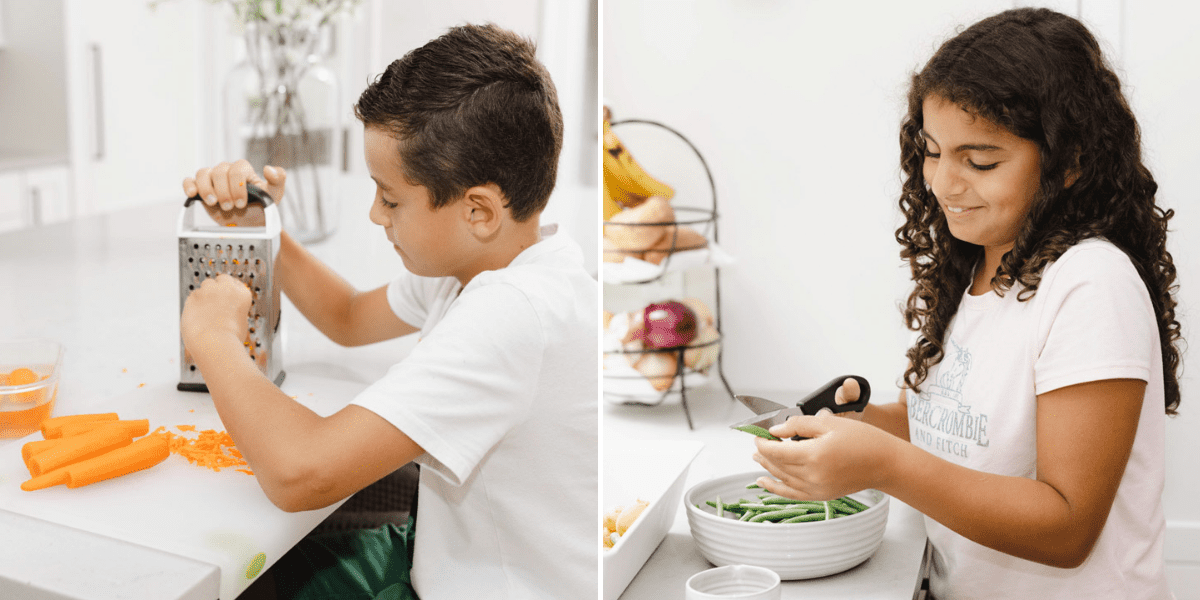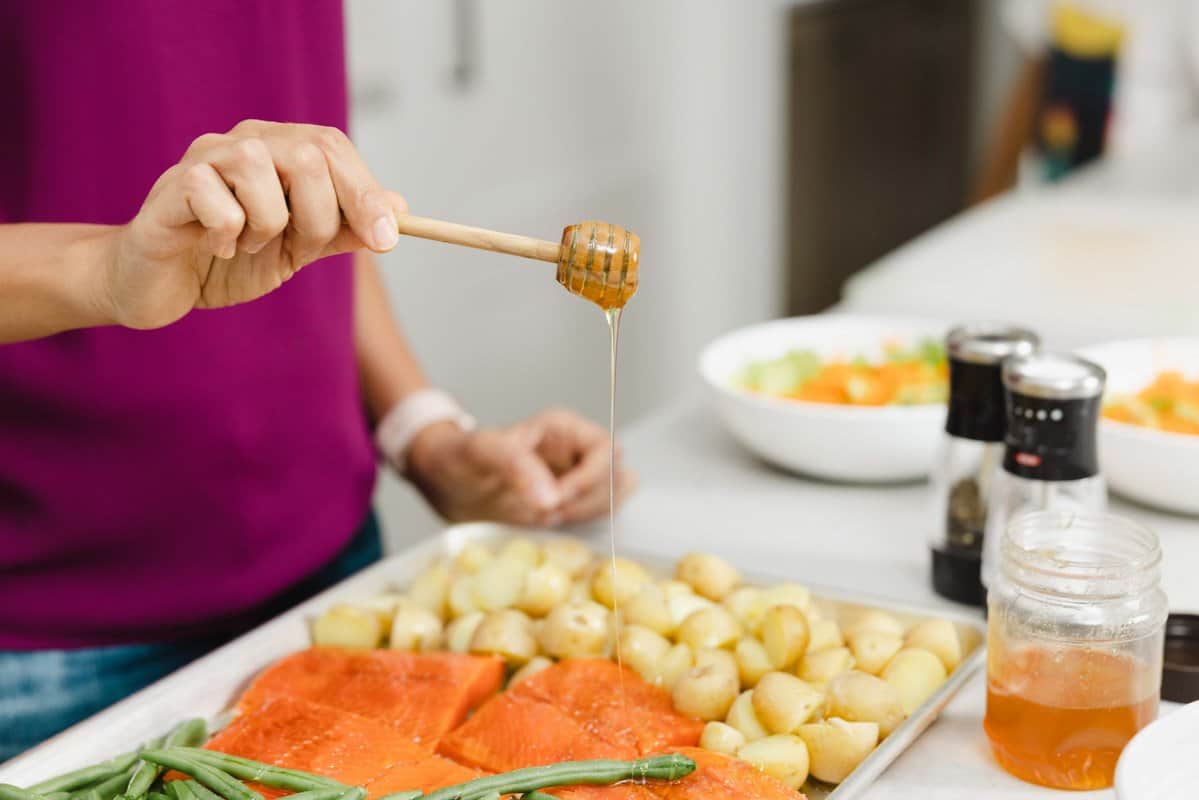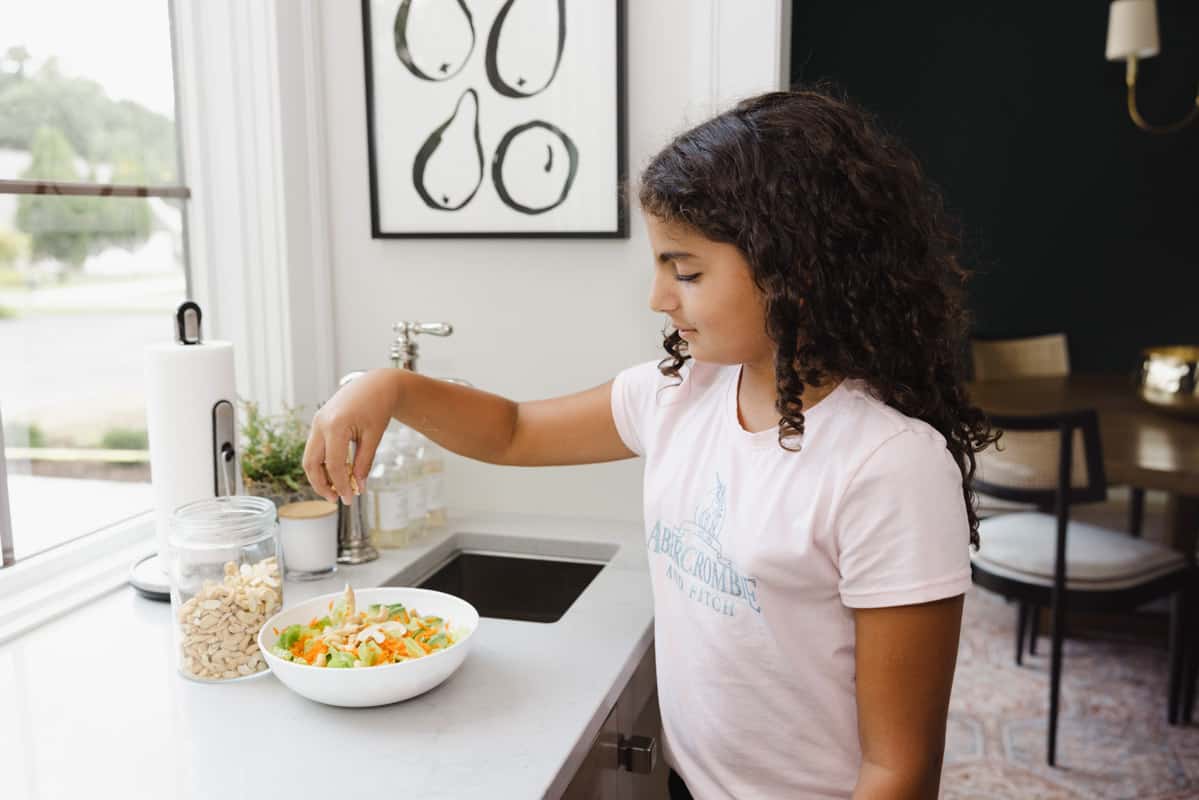How to Get Picky Eaters to Try Food
Published May 11, 2022
Need help getting your picky eater to try new foods? With these 10 tips you're sure to get your kids trying and eating new foods in no time!
This post may contain affiliate links. Please read our disclosure policy.
If you are the parent of a picky eater, you know how challenging it can be to get your child to try new foods. Especially when it seems like they will eat only a select few things, and everything else is met with a refusal. This can be frustrating for both the parents and children. But, barring true problems – food allergies or a child with a sensory processing disorder – kids can become adventurous eaters.

Yes, even my own kids can be picky sometimes! But, in this post, I will discuss the tips and strategies I use to get them to venture out and try new foods, and, dare I say – even look forward to it!
Why are some kids picky eaters and others are not?
There are a variety of reasons why some kids are picky eaters, and others are not. It could be a matter of temperament or personality, and some kids may simply have a more sensitive palate than others. Texture aversion is also common – many kids do not like certain food textures, whether it be slimy, crunchy, or chewy. And, some kids may have experienced a negative association with a particular food – maybe they got sick after eating it, or they had a bad experience with it in the past.
Additionally, many experts believe that early feeding experiences can play a role in whether or not a child becomes a picky eater. If a child is introduced to a variety of foods early on and has positive experiences with them, they are more likely to be adventurous eaters as they grow.
What is normal picky eating for a child?
Picky eating is common in young children and can last well into the elementary years. It is considered to be normal for kids to go through phases of being more or less interested in trying new foods. And, it is not uncommon for a child who was once a picky eater to outgrow it and become more adventurous later on. They may want to eat PB&J every day for lunch for months, and then one day, they wake up and decide they want to try something new.
According to Mana, if your child eats 20+ different foods, that’s considered normal. If your child eats between 15-19 different foods, that is still within the realm of “normal” picky eating. And, if your child eats 14 or fewer different foods, this is when you may want to consider seeking help from a professional to address the issue.
That being said, most picky eaters can work it out at home with the help of their parents. It’s important to keep the eating environment positive and not force your child to eat anything they’re not comfortable with.
10 Tips To Help Get Your Picky Kid To Eat
One of the questions I get asked all the time is – how? How do I get my kids to eat new foods? To which I always answer, that there is no one-size-fits-all solution. Every child is different, and what works for one may not work for another. However, there are some general tips and strategies that can help even the pickiest of eaters to try new foods.
Here are 10of my go-to tips for getting picky eaters to try new foods!
1. Buy new foods regularly
They can not try it if you don’t buy it. I know, I know you’re probably rolling your eyes and saying “well… DUH!” to yourself but hear me out.
If you want your kids to try new foods, you have to make them available in the house. If you never buy broccoli, they’re not going to eat it. But if you buy it regularly and put it on their plate (even if they don’t eat it), they will become more familiar with it and may be more likely to try it down the road.
So, every time you’re at the grocery store, pick out one new food to buy and add it to your cart. It doesn’t have to be anything fancy or expensive – just something new that they haven’t tried before.
Often, we think of the waste that comes with buying new foods for our picky eaters, but truth be told, even if they don’t end up eating it, you can always find a way to use it. Broccoli can be added to soup, and carrots can be used in muffins, and so on. Instead of piling their plate high with broccoli, start with 1 piece. Even a single bite is a well-accomplished task for a picky eater.
Even better, take your child shopping with you and let them pick out the new food they want to try. This will make them more excited about helping you prepare it when they get home, testing it, and may help them to be more open-minded.

If you’re concerned about food waste, make a rule that everyone has to at least touch or taste the new food. This is an excellent strategy for getting even the pickiest of eaters to at least try a new food.
The rule can be that everyone has to touch or taste the new food, or if they’re really not comfortable with that, they can at least smell it. The key is to make sure that there are no exceptions to the rule. If one person doesn’t have to try it, then nobody does. This takes the pressure off of the picky eater and makes it more like a game.
2. Cook together
Cooking together is a great way to get your kids involved in the kitchen and to make them more interested in trying new foods.
When you’re cooking, let them help with simple tasks like stirring the pot or adding ingredients to the bowl. If they’re old enough, you can even have them help with more complex tasks like chopping vegetables.
The key is to make it fun and not to put too much pressure on them. The goal is to get them interested in trying new foods, not to turn them into master chefs.

3. Grow your own food
Gardening is a great way to get kids interested in trying new foods. When they see the food growing and then get to harvest it, they’re much more likely to be excited about trying it.
If you don’t have a lot of space, you can even grow some vegetables in pots on your patio or balcony. Herbs like basil, oregano, and mint are also great for growing in small spaces. You can even take a trip to a local farm and let them pick their own fruits and vegetables.
4.Talk about taste & ingredients
Educate your kids about family recipes and traditions, whether they are complicated heirloom recipes, making scrambled eggs every Sunday, or memorable meals your family has shared.
This can start very young. The Mayo Clinic recommends asking your baby how the food feels, smells, and tastes. Is it salty or sweet? What color is it? What shape? Is it hot or cold?
Looks at nutritional labels and see if their inquisitive natures will help them make better choices.
5. try The one-bite rule
American Mom Pamela Drucker is raising her children in France and wrote Bringing Up Bébé about the experience. She is enamored of the French attitude toward feeding children, especially the way they insist that their kids take one bite of something new.
In a 2012 interview, she said, “ The main principle is you don’t have to eat it all. You just have to taste it. The French genius is that they hone in on one or two things that really do work, like the tasting principle, and they don’t change lanes if it’s not going well.”

6. Be creative
The Mayo Clinic recommends mixing it up and trying various preparations of the same food. If roasted carrots don’t work, try a grated carrot salad or crinkle-cut carrot fries. Cut fruits and sandwiches into different shapes
British chef Jamie Oliver makes colorful additions, like cooked peas, beets, or carrots to plain mashed potatoes, turning them fluorescent. Read the Harold and Purple Crayon and turn pancakes purple with mashed blueberries!
Add a drizzle of honey to veggies when roasting them!

7.Be patient, super patient
The American Academy of Pediatrics says it can take as many as 15 times before a child will accept a new food. So, serve the new foods, alongside old favorites, but do not give up.
For any reluctant eater with a delicate appetite, big portions are off-putting, so try small portions a little at a time.

8. Avoid distractions
Add a dose of mindfulness to meals. Mealtime should be about eating and talking. Besides new food, your kids are learning important social skills. Try to ban devices and tv.
As much as you can, establish regular meal times and respect them. Kids love routines
9. Veggies first
Author Karen Le Billon (another Francophile) has an entire book, Getting to Yum, about making children healthy eaters. One of her ideas, stolen from the way French school lunches work, is serving the first course of vegetables when children are hungry and more likely to eat them. The main entree is not served until the vegetables are gone – or at least tried.
Jamie Oliver uses a similar trick, by keeping crudités close by when he is cooking. If one of the kids says they are starving, that is what they offer.
Let the kids build up an appetite by limiting snacks throughout. Close the all-day buffet.

10. Resist making special meals
It’s hard, but the experts agree this sets up a bad cycle of making more work for parents and encouraging fussiness on the part of kids.
If your child does not like what is offered, encourage them to sit at the table and talk.
Try doctoring the main meal in a way they might like – for example blending chunky soups and offering them bread to dip it with.

I hope you’ve found these 10 tips for how to get kids to try new foods helpful. And don’t worry if you don’t see instant results. Be patient in the process, supportive, and have fun with it!
More cooking resources:
- How to Cook with Kids
- 17 Breakfast Ideas to Make with Kids
- 16 Pantry Meal Ideas
- 15 Easy No Bake Desserts
If you find this guide for How to Get Kids to Try New Foods useful, I’d love to hear from you! And if you snapped some shots of any of these tips and tricks, please share it with me on Instagram so I can repost on my stories!






